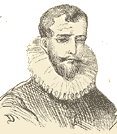Henry Hudson, the English navigator, failed in his great quest to find an all-water route to the East, but was rewarded for his efforts by having a number of prominent North American geographic features named in his honor.
 Little is known of Henry Hudson’s early life, but he apparently gained enough seafaring experience to be hired by large maritime concerns. One of these, the Muscovy Company of England, engaged Hudson in 1607 to lead an expedition in search of a northeast passage. The venture was blocked by ice and strong winds; a second attempt the following year encountered the same conditions.
Little is known of Henry Hudson’s early life, but he apparently gained enough seafaring experience to be hired by large maritime concerns. One of these, the Muscovy Company of England, engaged Hudson in 1607 to lead an expedition in search of a northeast passage. The venture was blocked by ice and strong winds; a second attempt the following year encountered the same conditions.
In 1609, Henry Hudson was chosen by the Dutch East India Company to lead their effort to discover a water passage to the east. Hudson sailed from Amsterdam with a largely Dutch crew aboard the Half Moon. Like the earlier efforts, the venture encountered severe weather, which prompted stirrings of mutiny among the crew. At this critical juncture, Hudson decided to violate the orders from his sponsors.
Henry Hudson, like many navigators of his era, had heard rumors about all-water passages to the west — the opposite direction from that mandated in his instructions. One popular story stemmed from a voyage taken by George Weymouth in 1602, in which the explorer speculated about the existence of a passage through northern North America to the Pacific Ocean. A somewhat different account came from the explorations of John Smith of Jamestown fame, who reported his belief in a water route farther south.
With halting support from his crew, Hudson changed course and sailed west across the Atlantic. Investigating the southern regions first, the Half Moon crew probed Chesapeake Bay and Delaware Bay, but concluded they did not lead to the Pacific. Hudson moved north into New York Bay, an area visited earlier by Giovanni da Verrazzano.
Hudson’s party sailed north up what would become the Hudson River, stopped occasionally to trade with the local natives, and proceeded as far as present-day Albany. This voyage established a Dutch claim to the region and Hudson’s report sparked interest in Holland by detailing opportunities for agriculture and fur trading in the valley that would bear his name.
In 1610, again in the employ of English investors, Henry Hudson headed a venture designed to follow up on Weymouth’s speculation. The Discovery sailed to the far north and passed through what would become the Hudson Strait between Labrador and Baffin Island. When the party first entered Hudson Bay, it appeared that they had found the Pacific Ocean.
Weeks were spent to explore the area, but it became apparent that the long-sought passage had not been found. Plunging temperatures soon formed ice, which locked the ship in place for the winter. The crew seethed as monotony grew and starvation loomed.
When the ice broke in June 1611, the bullheaded Hudson wanted to explore farther to the west, but the crew mutinied. The captain, his son and seven others were set adrift in a small boat. No food or water was provided and they were never seen again.
A few of the crew members eventually managed to return to Europe, but chose to go to England rather than Holland. They were never punished for their mutiny.
Henry Hudson established New World claims for the Dutch in what would become the New York area, and for the English in northern Canada.